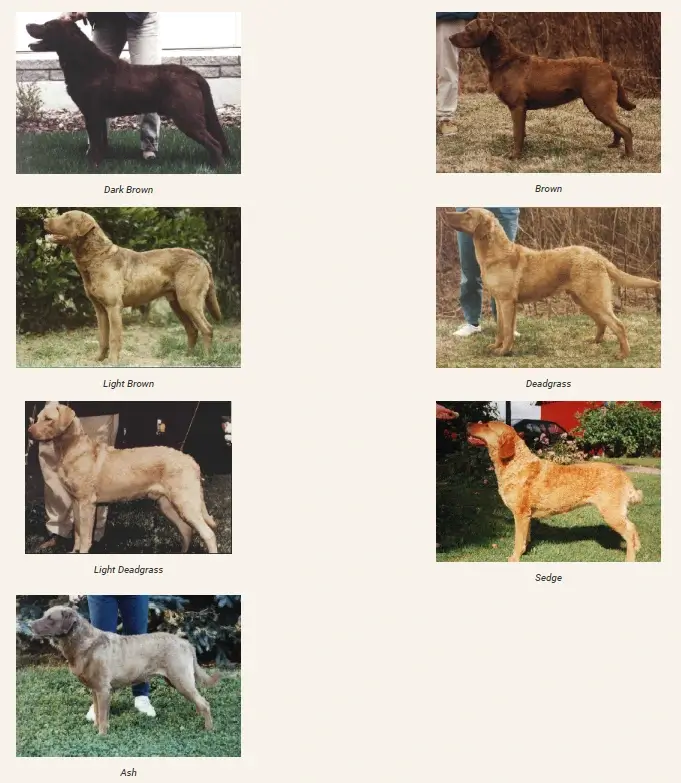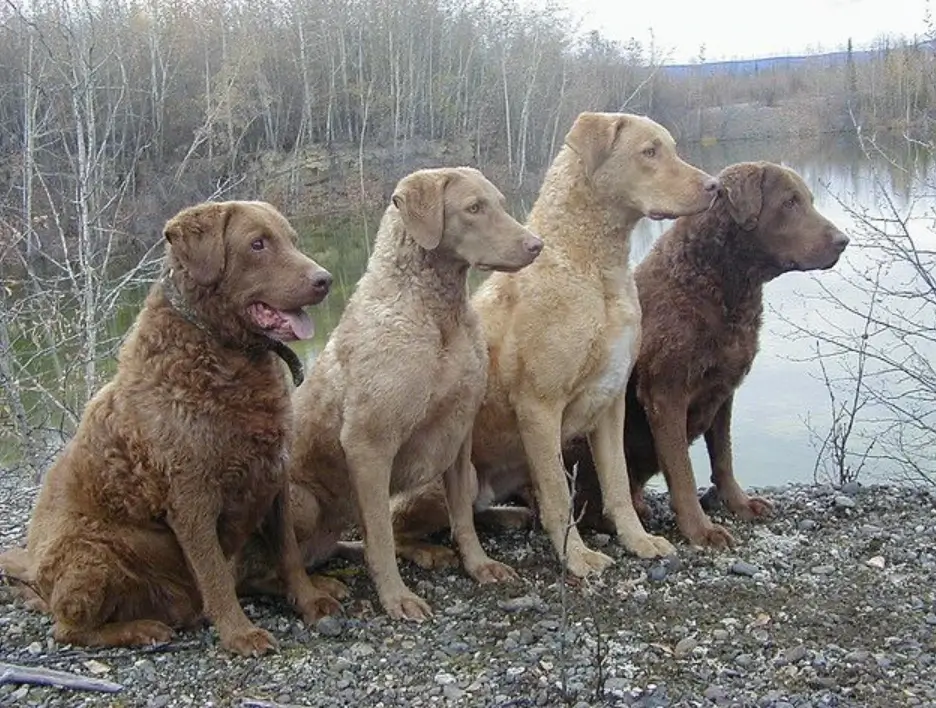Chesapeake Bay Retrievers exhibit a range of coat colors that contribute to their distinctive appearance. This article will provide an overview of the various Chesapeake Bay Retriever colors and the genetics behind the breed’s trademark earthy hues. Read on!
Chesapeake Bay Retriever Colors
Here are the common Chesapeake Bay Retriever colors:
- Dark Brown – Very deep, rich, dark chocolate brown color. The darkest brown you’ll get in the breed but shows intensity.
- Brown – Encompasses the average brown shade most typical of the breed. Anywhere from a medium to moderately dark brown.
- Light Brown – A lighter brown that retains enough brown pigment not to be true tan. Sometimes, it appears dark tan but still has traces of being brown-based.
- Deadgrass – Mix of brown hair ticked with subtle yellowish tones like dried brown grass. Gives a brownish-golden cast.
- Light Deadgrass – A lighter version of deadgrass where more fading makes the yellowish dead grass tones more noticeable, mixed with light brown hairs.
- Sedge – A dull reddish faded brown color with traces of tan mixed throughout the coat, producing a brownish-tan appearance.
- Ash – Very rare grayish faded brown that lacks richness and appears almost metallic brown to gray minus typical warm brown tones. Undesirable compared to other shades.

Image: American Chesapeake Club
Genetics Behind Chesapeake Bay Retriever Colors
Chesapeake Bay Retrievers inherit their coat colors through genetics and breed-specific traits. The color variations, including deadgrass shades and tan points, reflect the breed’s genetic composition.
The main genetic loci affecting coat color in dogs include the A locus (Agouti), B locus (Brown), E locus (Extension), D locus (Dilution), and other modifiers. Here’s an overview of how these genetic factors contribute to the coat colors observed in Chesapeake Bay Retrievers:
A Locus (Agouti)
The A locus influences the distribution of black and yellow pigments in the coat. Chesapeake Bay Retrievers commonly have a solid coloration, and the presence of the recessive “e” allele allows for the expression of yellow or red coat colors.
B Locus (Brown)
The B locus determines whether the black pigment is expressed. The dominant “B” allele allows for the expression of black, while the recessive “b” allele results in brown (chocolate) coat color.
E Locus (Extension)
The E locus determines the extent of eumelanin (black pigment) in the coat. The dominant “E” allele allows for the full expression of black, while the recessive “e” allele results in a red or yellow coat color.
D Locus (Dilution)
The D locus influences the intensity of coat color. The dominant “D” allele results in full pigmentation, while the recessive “d” allele dilutes the coat color. Chessies typically do not carry the dilution gene for a diluted coat.
Modifiers
Other modifying genes and alleles can influence the shade and pattern of the coat. These modifiers can create variations in intensity, shade, and markings.
Two main genes determine Chesapeake Bay Retriever coat color – the B and E locus. The B locus controls black/brown pigment (eumelanin). Variants at this locus lead to brown/red shades ranging from liver to reddish tan. The E locus affects the production of black pigment. Dominant alleles allow black pigment, while recessive e leads to reds. Other genes such as agouti signaling, McCune dilute locus, ticking patterns, and more can subtly alter ChesapeakeBay Retriever colors as well.
Does Color Influence Health and Behavior?
The health and behavior of the Chesapeake Bay Retriever are not influenced by its color. Scientific evidence does not support any correlation between coat color and health/behavior. Temperament remains consistent across colors, and color variations do not impact hunting abilities/disposition.
What is the Rarest Color among Chesapeake Bay Retrievers?
The rarest color among Chesapeake Bay Retrievers is sedge. This unique and less common variation is characterized by dilute red with lighter shadings. Chesapeake Bay Retrievers with sedge coloring have a distinctive and sought-after appearance, adding to their appeal.
Conclusion
In conclusion, Chesapeake Bay Retrievers come in various colors, each with unique characteristics and appeal. Whether you prefer the rich tones of brown, the subtle shades of dead grass, the vibrant sedge, or the striking ash or tan, there is a color that will capture your heart.
ALSO READ: Borzoi Golden Retriever Mix
FAQs
What are the most common Chesapeake Bay Retriever colors?
The most prevalent colors are different shades of brown, from a light sandy brown to a very dark brown. Brown is considered the hallmark color for the breed.
Is one type of brown color more valuable than others?
No, the American Kennel Club standard states that all shades of brown are acceptable. No single variation of brown is given preference over another.
How does a puppy’s color compare to its adult coat?
Chesapeake puppy coats tend to be slightly lighter than their eventual adult color. But most retain the same general color spectrum as they mature.
Can yellow/blonde or chocolate brown Chesapeakes occur?
Very light yellow or blonde coats and chocolate browns are quite rare or atypical for the breed. Most breeders aim to breed dogs within the expected brown shade variations.
Do white markings or spots appear in Chesapeake Bay Retrievers?
White markings on the coat and skin are grounds for disqualification in conformation showing. Breed standards call for a uniformly colored coat.
